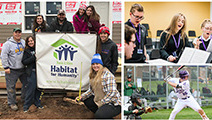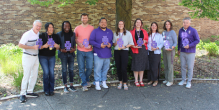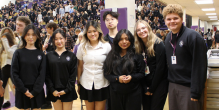Co-Curriculars Round Out the Educational Experience at Cretin-Derham Hall
Reprinted from Traditions, Summer 2018
September 24, 2018
For most Cretin-Derham Hall students, the school day lasts far longer than eight class periods.
It is estimated that 95% of CDH students participate in one or more co-curricular activities. Broadly grouped into three categories, the opportunities for today’s students to extend their learning and personal development beyond the classroom are wide and varied.
Co-curriculars at CDH include opportunities in:
• Athletics. With 28 different sports and teams at all levels, 74% of students participate in at least one sport. There are 15 sports for girls and 13 sports for boys with multiple levels. Many sports do not cut.
• Campus Ministry. Service and worship leadership gives students a chance to put their faith in action, with opportunities such as LaSallian Youth, worship planning, service days, and more.
• Clubs and Organizations. Activities vary from academic competitions such as Science Olympiad, Speech Team, and Mock Trial to creative outlets such as Art Club, Band, Choir, and the Yearbook. Service opportunities include clubs such as JROTC, Highland Friendship Club, and the Sustainability Team. Add in non-varsity athletic fun such as Bowling, Clay Target Team, or Intramural Basketball — plus leadership opportunities such as Link Crew, National Honor Society, and Student Council — and you have something for literally just about everyone.
“If students have a new idea, there are opportunities to add even more clubs,” noted Aaron Benner, Activities Director and Ninth Grade Dean. He points out that next year, there will be new clubs offered because students took the initiative.
For instance, the Sustainability Club was the brainchild of a couple of students who had a passion for recycling and the environment. “The students came to me with a really good idea, and after working through details and soliciting an adult coach/mentor, this new club will be offered to the student body next year.”
While many clubs and organizations, in some form, are common to most high schools across the board, some of these student initiatives have proven to not only be successful over time, they have become a distinctive part of the CDH experience. Empty Bowls, a service project in which student sell soup in hand-made ceramic bowls to raise money for Heifer International, was started by a student nearly 16 years ago. Following the 2018 Empty Bowls, this effort has raised more than $138,000 and is widely considered a not-to-be-missed event attended by students, families, and many alumni each year at CDH.
Value of Co-Curriculars
Much educational research has been done to determine the value of co-curriculars in high school. While it is not surprising that students enjoy participating in these ‘extra’ activities outside of traditional academics, it is interesting to note that many students benefit from the ‘soft’ skills learned in co-curriculars that can be difficult to gain in traditional classroom settings alone.
“Our goal at CDH is to offer an education that supports students to be well-rounded individuals,” explained Aaron Benner, Activities Director. “Of course this puts academics first, but there is so much more students can learn outside of the classroom to develop mind, spirit, and soul.”
As an example, Benner points to the value of co-curriculars in building community, which in turn challenges participants to solve conflicts within unique group dynamics, explore leadership skills, pushes students to responsibly get things done, and form strong bonds between members. “Time management is key,” said Benner. “If a student wants to do well in school and play Lacrosse, for example, he or she needs to be focused and make quality time for homework because they also are responsible for contributing to the daily Lacrosse practices and games.”
Research shows that there is a strong correlation between participation in co-curriculars and both academic achievement and better behavior. Students learn skills and build work habits which have a life-long impact. In addition, students in clubs, activities, and sports must hone their time management and goal-setting capabilities. Participating in co-curriculars support the self-discovery of passions and interests and builds self-esteem.
In the Class of 2018, the top 10 students each listed an average of 6.3 sports, clubs, or Campus Ministry activities that they were involved in, with many students noting that there were more.
Lou Anne Tighe, Campus Ministry, points out that the co-curricular opportunities for students can also help students find their purpose in life. She often hears stories from alumni who believe their experiences in high school served to launch their interest in what would eventually become their life’s work.
Such was the experience for Kate Townley ’00, the Senior Manager for Minor League Administration for the Minnesota Twins. She was recently inducted into the CDH Athletic Hall of Fame and shared how valuable her sports and co-curricular participation was to her learning. “In most business environments, you are working with others that share your same goal of striving for success...and you should want to succeed not only for yourself, but for the company. This was instilled in me at a very young age because of the sports I played. I have loved being a part of a team and I am very fortunate that I continue to be involved in the arena of sports.”
Goal for Students: Participation
Mona Passman, Principal, encourages students to find something to join right away as a ninth grader. “Whether a student wants to try theater, a sports team or one of our many clubs, participating in one of the co-curriculars is very important to their first-year experience.” There are many opportunities to find out more about what is offered, including new student orientation, an Activities Fair early each fall, and the daily announcements.
She believes that one thing that makes CDH distinctive is the fact that there is such a high participation rate in co-curriculars. The great majority of our students find ways to be a successful student while participating in one or more activities. “Our culture here encourages students to participate in multiple things throughout the year.” She proudly points out that it is not at all unusual for a marching band member to also play football or an Empty Bowls coordinator to compete in Robotics and perform with the Choir.
The co-curriculars are usually fun for students because they are choosing the type of activity they plan to join. Because of the shared interest and the reliance on the group that is inherent in so many of the activities, there is a distinct benefit to all participants, no matter the skill or the mastery, in being a part of the activity which promotes a sense of belonging.
“High school is a time of great growth for our students,” commented Passman. “To have a small community of like-minded peers who know you is a really important step in feeling welcome and confident.”
Coaches and Mentors
None of the activities would be possible without the adult leadership. The coaches and mentors who lead the teams and clubs are committed to creating a valuable experience for the students. These adults who lead the activities invest significant time and energy with their team or club because they believe the experience is worth it for their students.
Interestingly, a high number of our coaches and mentors are alumni who believe in the value of their own personal experience so much, they are willing to come back and make the experience positive for current students. For instance, 11 of the 13 coaches at all levels of the baseball program are alumni. Two-thirds of both boys and girls swim and dive and boys hockey and tennis programs are alumni. The amount of alumni that come back to coach is impressive.
Phil Archer ’99, Athletic Director, is one of those alumni who was thrilled to have the opportunity to return to CDH, where he believed so much of his personal and athletic success was built on the foundation he experienced while a Raider athlete himself.
“I know how important it is that our athletes have strong, positive adult leadership. I have the distinct honor to work with so many of our dedicated coaches who put in 110% for our student-athletes,” said Archer.
“It is always special to have one of our former Raiders come back to coach our athletes today — they have a special connection and vision for what it meant for them to be a Raider and they want to give back to our current students,” noted Archer.
Activities Support Classroom Learning
Principal Passman points out that several of our co-curriculars are organized in such a way that they occur during the school day, although often the extra work and extra opportunities that students can take advantage of occur outside the school day. For instance, Band and Choir are both classes and have many performance opportunities outside of class for those students who want more.
Yearbook is also a class. Nick Giles ’03, Yearbook Moderator, notes that the value of this group of 15-20 students who produce the yearbook cannot be overstated. “Students on Yearbook go to multiple Yearbook Conferences during the year, including summer. They make everything, from deciding exactly where a photo is placed to writing the copy that records the stories of the school year.” With deadlines to meet, the work can be intense and Giles knows these students learn how to create a professional level book.
Giles points out that this extra effort really pays off for those students who have an interest in design, layout, journalism, and photography. “The Yearbook marks the end of the school year and acts as an overview of the entire year. It is exciting when the book comes out and we see hundreds of kids walk the halls admiring it.”
Building Community
Benner, in his dual role as Dean and Activities Director, and Archer as Athletic Director agree that these co-curriculars help students shape their futures in a very real way, but the best part of having such a wide slate of opportunities for students is the sense of community it builds.
“Finding other students who share your interests and have similar goals as you is very important during these high school years,” noted Benner. A sense of team is not just about sports, but about working together for something bigger than ourselves. I often hear students say they make their best friends through the activities they choose to participate in.”
Archer takes it one step further. “Our community reflects our individual students. We are developing the whole person, so things like character, morality, and respect are important lessons, and most of these life lessons occur because there are strong opportunities at CDH to develop both in and out of the classroom.”
Subscribe to our e-Newsletters
You might also like:
CDH Honors Faculty and Staff at Annual Year-End Luncheon
At the June 4 luncheon, Cretin-Derham Hall recognized faculty and staff with awards, service milestones, and farewells to this year’s retirees.
Class of 2025 Graduates and Shares One Last Day Together
Cretin-Derham Hall’s Class of 2025 celebrated graduation on May 28 with a full day of traditions, recognition, and community - from Mass and brunch to commencement and the senior lock-in.
AAPI Heritage Month is Celebrated with Music and Reflection
On May 19, CDH celebrated AAPI Heritage Month with performances by Gao Hong’s ensemble and a student band, plus a reflection by Yolanda Xu ’26.





